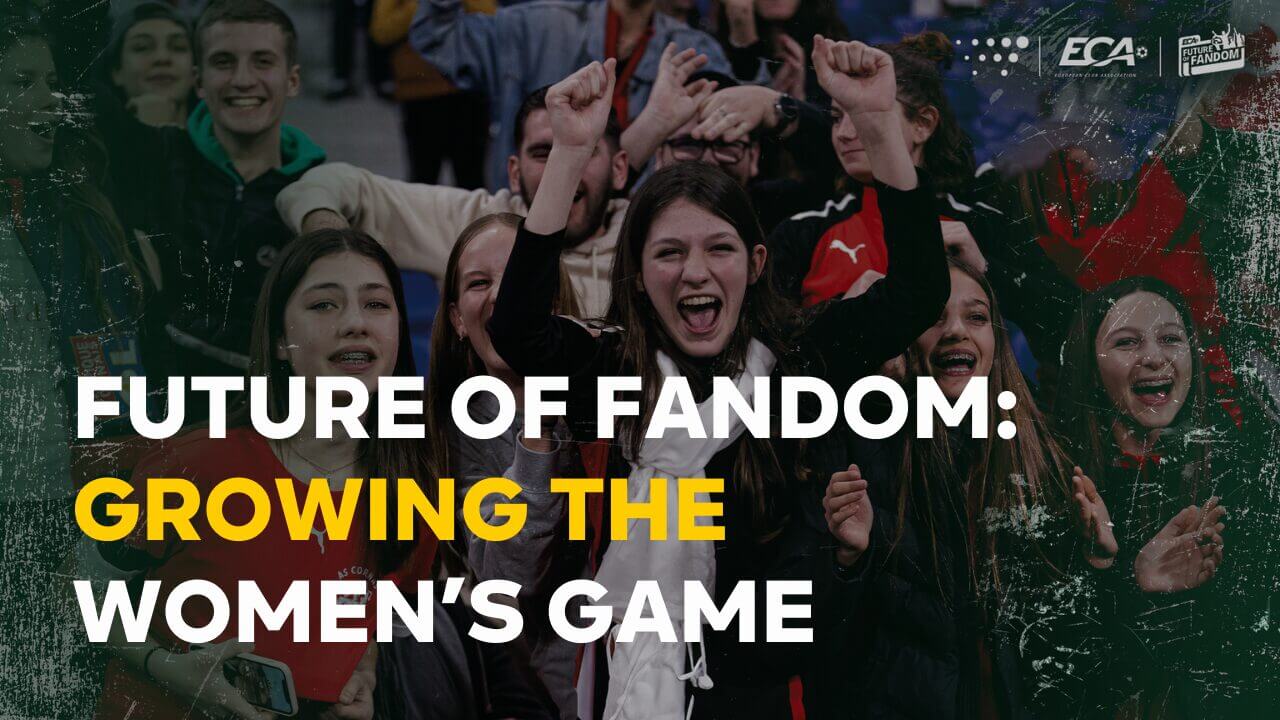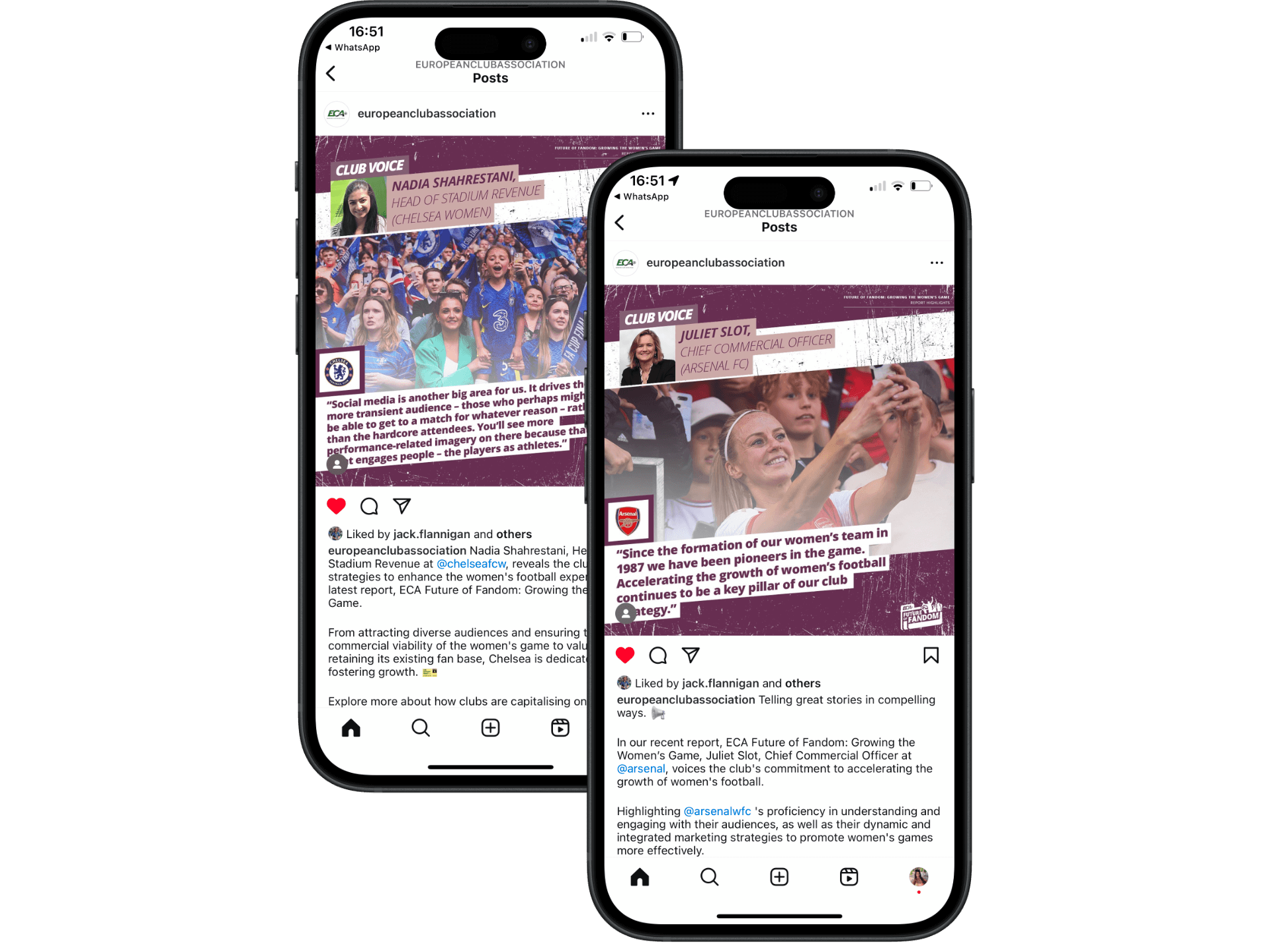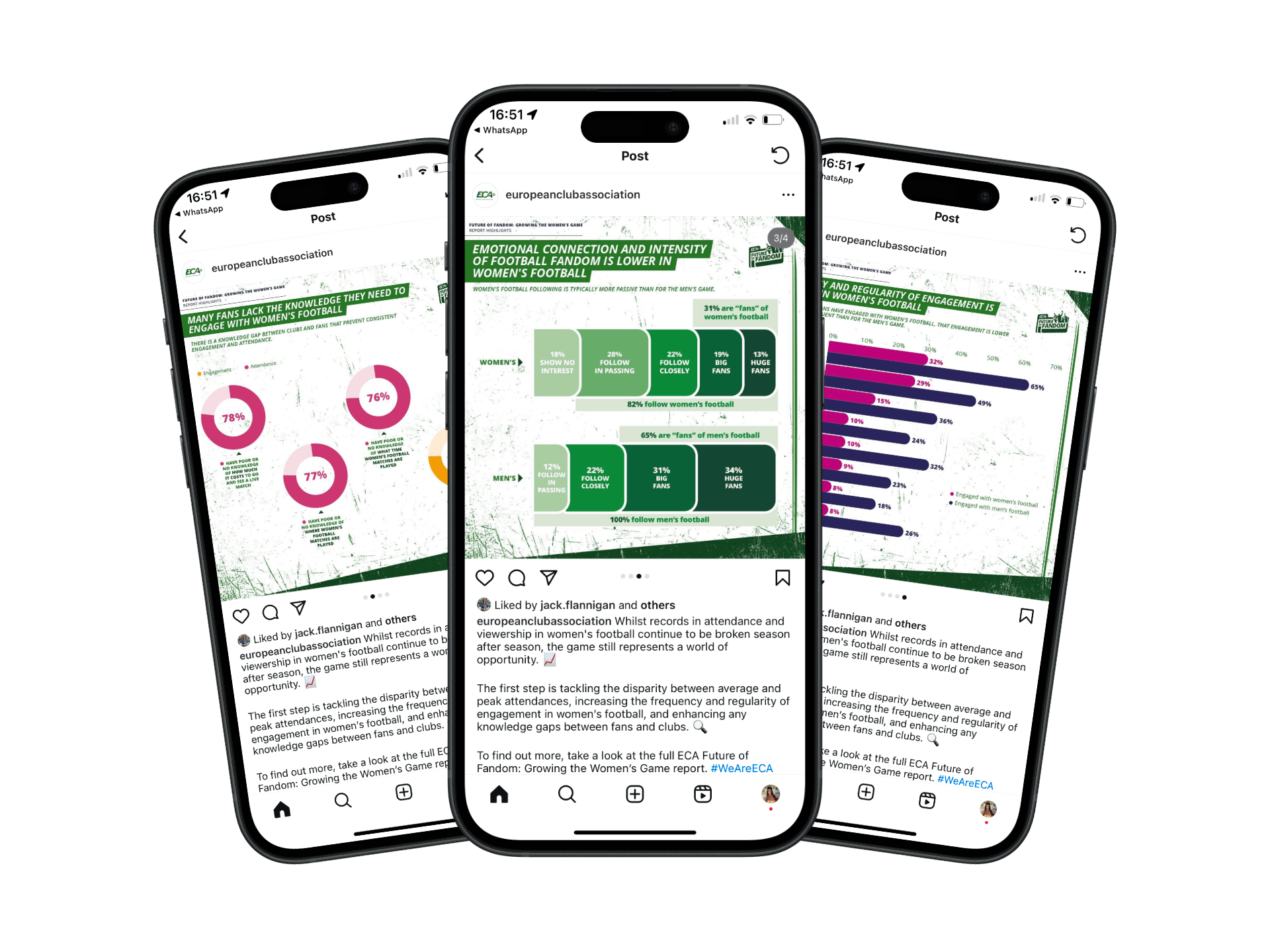
Growing the women’s game: ECA’s valuable research into Women’s Football Fandom
The landscape of women’s football fandom is in a constant state of evolution. Despite consistently setting new records in attendance and viewership each season, there exists untapped potential that warrants industry-wide attention.
Earlier this season, our partner, the European Club Association (ECA), explored this ever-changing landscape in a report, titled “Future of Fandom: Growing the Women’s Game” which traces the growth of women’s football, unveiling insights into the audience’s demographics, motivations, and the strategies employed by clubs to overcome challenges.
In collaboration with the ECA, we developed a social media strategy to coincide with the report’s launch. Leveraging the expertise of our in-house studio to create engaging content that not only highlights key insights but also amplifies the voices of the clubs featured in the report.
Ahead of the report’s launch, we had the opportunity to sit down with WePlay’s Client Director Sharon Bennett and Account Executive Gina Sparks to delve deeper into their insights on the report and how it can benefit clubs across the continent.
What are the key challenges that clubs need to overcome to grow the women’s game?
Gina: Even though we’re smashing records for attendance and viewership, there’s still this huge untapped potential hanging in the air. The big question on everyone’s mind is: how do we transform this significant level of engagement and the large attendances seen in blockbuster fixtures into more regular and widespread attendance and engagement?
Sharon: Absolutely agree. Clubs need to build a sustainable business to in turn build growth and financial stability across the entire football pyramid. The £30M fund to deliver pitches for girls and Women’s football is a great start! Solid economic and revenue models will make clubs and women’s football more appealing to investors and partners. Providing affordable or free access to football at schools and in the community is a must.
How can we increase attendance and engagement in women’s football matches?
Sharon: Women’s football is different, and clubs should acknowledge and embrace this by looking closely at the full fan journey – one size doesn’t fit all. Ticket pricing, ticket packaging/bundles and accessibility. Clubs like Lewes are seeing growing numbers of diverse fans watching the women’s game as they create a more inclusive experience. Removing barriers with community engagement, matchday experiences including different F&B, events and activities, hospitality experiences and travel and transport guidance.
Gina: Absolutely, clubs need to enhance accessibility by address those more practical barriers but also by communicating specific information about matchdays on the most suitable platforms. The ECA report highlights the need for this and the importance of dispelling misconceptions about value and affordability. We also need to encourage fans to want to engage more by communicating compelling narratives, and utilising players’ personalities on their social channels – this will naturally result in forging deeper connections with fans and attract a broader audience to women’s football in general.
How can clubs educate fans and develop deeper emotional connections to increase engagement?
Gina: Clubs need to recognise that a significant portion of their fan base are new, prompting the need to proactively share narratives.
As seen in the report, half of fans claim to follow football because of an emotional investment, a sense of community, or another emotionally driven reason. But, around three-quarters of followers know little or nothing about the rivalries or storylines that exist in women’s football, diminishing the emotional impact of matches. The report spotlights how clubs are using social media channels to strategically overcome this challenge.
Sharon: As Gina said, many Women’s football fans are new to the game, in fact Juliet Slot, Arsenal Chief Commercial Officer, quoted on Game Changers Podcast that 60% of fans to their Emirates games are new to football. It’s critical that clubs take time to understand their audience with data and insights.
Women’s football fans are unique (not a cut and paste of men’s), and research tells us that they are generally digital natives, born on social, they feel comfortable online, exploring, discovering and engaging, and so clubs should ensure they connect with fans across the fully digital-ecosystem, with an omni-channel approach. Content should showcase player stories, their background, their journey and how can clubs use their brand (and the players) as an engagement platform. Players should also get behind match-day content and pushing ticket sales.
What role do broadcasters and brands play in valuing and supporting the women’s game?
Gina: I think brands play a crucial role in valuing and supporting women’s sports by aligning themselves with the values of diversity, empowerment, and purpose-driven initiatives. Broadcasters are also key in making content easily accessible. Successful strategies, like DAZN streaming all Women’s Champions League fixtures on YouTube and Burnley live streaming matches on TikTok, demonstrate this approach.
Sharon: Women’s football celebrates different values and purposes, and brands that want to connect with Gen Z or Next Gen should consider women’s football as a great platform to showcase their values. We know that Gen Z is more inclined to purchase or associate with brands that care about their impact, so for me, it’s time for brands to be bold and lead by example.
Brands and broadcasters go hand in hand. Brand partners want to reach audiences, and women’s football provides a great platform to do so. That said, without support from broadcasters, numbers cannot be reached as quickly, as globally. As Gina points out, using innovative and new streaming platforms is a great way to reach audiences. Broadcasters should be looking closely at their fixtures. They should ensure fair deals and adequate compensation for the value of their audiences and their partners.
How can we leverage the success and popularity of individual players, to attract more fans to the women’s game?
Gina: Absolutely, leveraging the success and popularity of players is a crucial strategy to attract more fans to the women’s game. Young fans often find a gateway into supporting a specific club through their favourite national players. But I think it’s also important that we amplify the voices of not only globally renowned players but also shine a spotlight on lesser-known athletes.
As you see in the ECA’s report, when a significant number of national team players are based abroad, this poses obstacles. For instance, YoungBoys have difficulties in that none of their national team play domestically. Despite that, the club is actively working to bring their own players and their stories to the forefront.
Sharon: I think it’s important to mention too that brand partnerships, activations and campaigns that showcase athletes and strong role models, will resonate with younger demographics and increase participation at lower levels of the game. If activated thoughtfully, the influence and celebrity of the top women players can be instrumental in shifting broader perceptions, breaking stereotypes and driving the credibility of women’s leagues/events. Their success and fan pull create those crucial entry points to draw in waves of new enthusiastic supporters.
What are some strategies for pricing women’s football tickets in a way that ensures commercial viability while also valuing the game?
 Gina: What is interesting is several clubs disclose their strategies for this in the research and Chelsea for example, elucidates how, the higher they set the ticket prices, the higher the attendance percentage. They believe offering a substantial number of complimentary tickets or pricing them too low leads to decreased attendance, especially if there are changes in the date, unfavourable weather, or similar factors.
Gina: What is interesting is several clubs disclose their strategies for this in the research and Chelsea for example, elucidates how, the higher they set the ticket prices, the higher the attendance percentage. They believe offering a substantial number of complimentary tickets or pricing them too low leads to decreased attendance, especially if there are changes in the date, unfavourable weather, or similar factors.
Sharon: Offering early entry discounted periods, family packages and promotions tied to merch purchases will help drive advanced sales and provide affordable options.
We also need to think about how we engage the local community and grassroots clubs. Subsidised ticket allotments will not only increase attendance, but it also creates opportunities for the next generation of fans. Consider tickets with wider benefits, such as ancillary benefits like meet-and-greet passes, signed merchandise and preferred stadium access as value augmentations at mid-upper price points.
We certainly hope to see continued growth and investment into the women’s game hinges on unlocking diversified revenue streams, of which ticket sales are a core.
In this dynamic era of exciting advancements, it’s important for stakeholders within the women’s football domain to actively magnify their efforts, foster collaboration and share knowledge to help unlock the game’s boundless potential.
We aspire to stand as a catalyst on this transformative journey, and we look forward to partnering with more women’s football projects in this year.
Contact us now to uncover how we can accelerate growth and make a lasting, transformative impact together.



